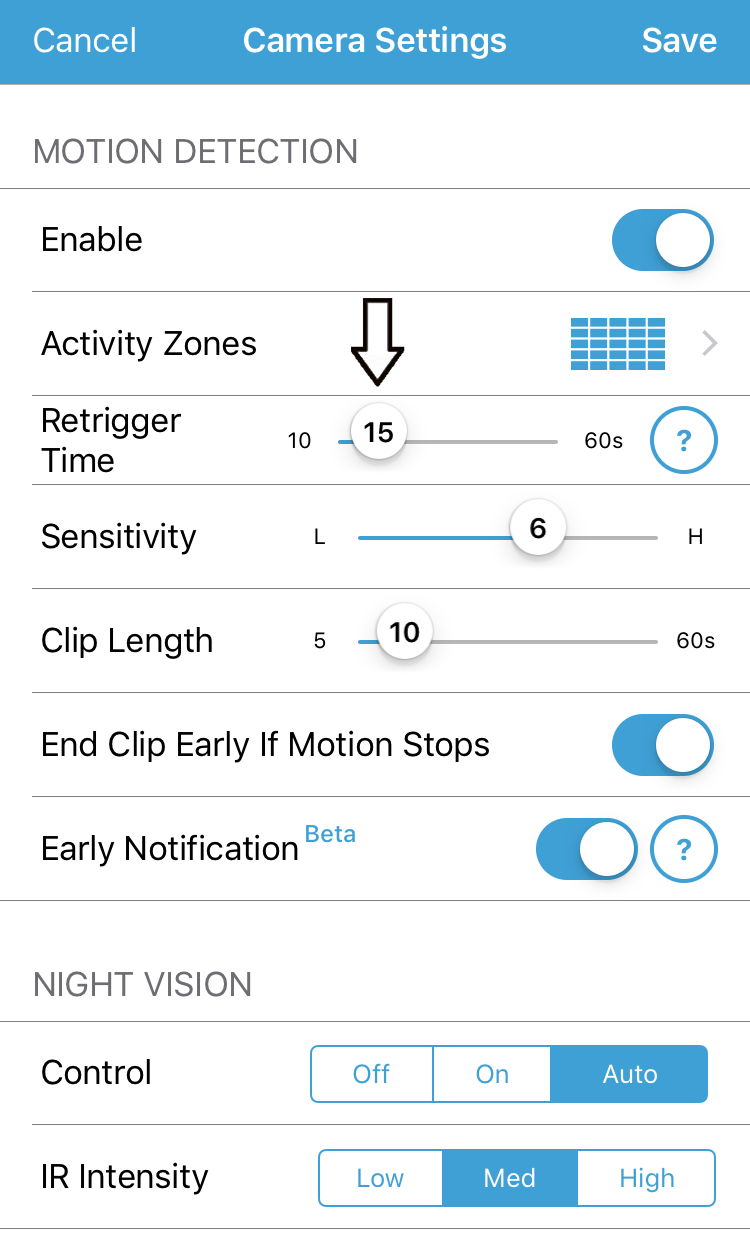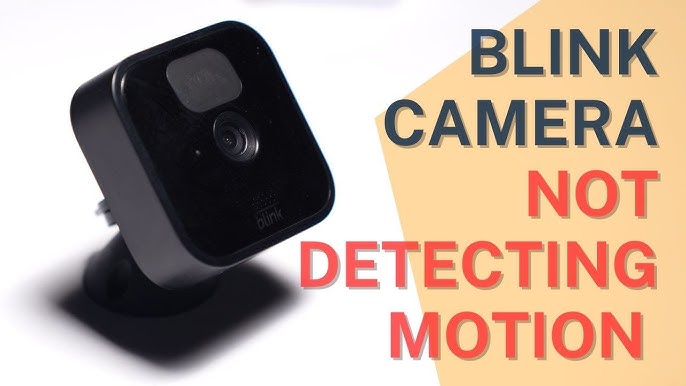If your Blink Camera isn’t detecting motion, check its settings and ensure it’s properly positioned. Faulty settings or incorrect placement often cause this issue.
Dealing with a Blink Camera that fails to detect motion can be frustrating. This smart device, designed to enhance home security by alerting homeowners of movements, sometimes misses the mark. The reasons behind this malfunction are not always straightforward, making troubleshooting a bit of a puzzle.
A common mistake users make is overlooking the sensitivity settings or the camera’s physical orientation. Ensuring these aspects are correctly configured can often resolve the problem. Remember, for a security device like the Blink Camera, optimal performance relies on both its software settings and its interaction with the physical environment. Addressing these factors can significantly improve its motion detection capabilities, providing the security and peace of mind it’s intended to offer.
Introduction To Blink Camera Motion Detection Issues
Blink cameras are smart home security devices. They keep homes safe. Sometimes, motion detection fails. Users find this frustrating. Let’s explore common issues and fixes.
Brief On Blink Camera
Blink cameras are wireless home security systems. They are easy to install. They work with an app. Users get alerts on their phones. Cameras record video when they detect motion.
Common Motion Detection Challenges
Users may face several issues. These include:
- False alerts: Trees or pets trigger the camera.
- No alerts: The camera misses movement.
- Battery life: Frequent triggers drain batteries fast.
- Wi-Fi issues: Poor connection affects performance.
Understanding these challenges helps users troubleshoot. Let’s dive into solutions.
Initial Troubleshooting Steps
If your Blink camera fails to detect motion, don’t worry. Let’s start with some basic troubleshooting steps to fix the issue quickly.
Check Wi-fi Connection
A stable Wi-Fi connection is crucial for the Blink camera to function properly. Follow these steps:
- Inspect router: Ensure it’s online and working.
- Signal strength: Camera needs strong Wi-Fi signals.
- Restart router: This can solve many connection issues.
- Check Wi-Fi settings: Camera should be on the correct network.
Verify Camera Placement
Correct placement ensures your Blink camera captures all motion activity. Consider these points:
| Placement Tips | Details |
|---|---|
| Height | Mount camera at least 7 feet high. |
| Angle | Aim it where movement is likely. |
| Obstructions | Keep view clear of obstructions. |
| Distance | Best detection within 20 feet. |
Ensure the camera faces the desired area for optimal performance.
Adjusting Motion Detection Settings
Blink cameras offer customizable motion detection. This feature ensures reliable alerts and security. If your Blink camera isn’t detecting motion as expected, fine-tuning these settings can help. Let’s explore how to adjust them effectively.
Modifying Sensitivity Levels
To start, adjusting the sensitivity levels is key. High sensitivity increases motion alerts. Low sensitivity reduces false alarms. Here’s how to modify it:
- Open the Blink app on your device.
- Select the camera needing adjustment.
- Tap on the “Motion Detection” setting.
- Slide the sensitivity bar to your desired level.
- Save changes and test the new setting.
Setting Up Activity Zones
Activity zones focus detection on specific areas. This helps ignore unnecessary movements. Follow these steps to set up:
- Access the camera’s settings in the Blink app.
- Choose “Activity Zones” from the motion detection options.
- Draw or select zones within the camera’s view.
- Save the zones to apply the changes.
By customizing these zones, your Blink camera will focus on areas that matter most.

Credit: www.amazonforum.com
Firmware And Software Updates
Firmware and Software Updates play a crucial role in the performance of Blink Cameras. These updates can fix bugs, add new features, and improve motion detection capabilities. Let’s dive into how you can keep your Blink Camera up-to-date.
Checking For Updates
It’s easy to check for updates. First, open the Blink app on your smartphone. Go to the Settings section. Here, you’ll find an option labeled System Update. If there’s an update available, it will show here.
- Open the Blink app.
- Navigate to Settings.
- Look for System Update.
Installing Latest Firmware
Installing the latest firmware ensures your camera works best. Follow these steps:
- Tap on System Update in the app.
- If an update is available, select Update.
- Wait for the update to install. Do not close the app.
After the update, your Blink Camera will restart. This process ensures your camera has the latest features for detecting motion accurately and efficiently.
Environmental Factors And Interference
Many things can stop a Blink Camera from spotting movement. Environmental Factors and Interference play a big part. Let’s explore these issues.
Effects Of Weather
Weather can confuse your Blink Camera. Here’s why:
- Heavy rain makes it hard to see movement.
- Strong winds move things like trees. The camera sees this as motion.
- Snow can block the camera’s view.
- Direct sunlight can cause glare. This makes it hard to detect motion.
These weather conditions can lead to false alarms or missed movements.
Physical Obstructions
Things in front of your camera can cause issues too. Here’s what to check:
- Plants can grow and block the view.
- Spider webs can trigger false motion alerts.
- Dirty lenses make it hard to see.
- Make sure nothing blocks the camera’s view.
Clean your camera and keep the area in front of it clear.

Credit: wasserstein-home.com
Power Issues And Battery Life
Many Blink Camera users face motion detection issues. Often, this ties back to power problems and battery life. Understanding how to maintain battery health and save power can prevent these issues. Let’s dive into some key strategies to keep your Blink Camera alert and active.
Battery Maintenance
To ensure your Blink Camera performs optimally, regular battery checks are essential. A weak or dying battery can lead to reduced motion detection capabilities.
- Check battery levels periodically through the Blink app.
- Replace batteries with recommended types for best results.
- Clean battery contacts with a dry cloth to ensure a good connection.
Power Saving Tips
Maximizing battery life means your camera stays operational longer. This reduces the chance of missing important events due to power loss.
- Set motion detection zones to focus on key areas.
- Decrease sensitivity to avoid unnecessary alerts.
- Use Scheduler to disable motion detection when not needed.
By following these tips, you can enjoy prolonged battery life and reliable motion detection from your Blink Camera.
Advanced Troubleshooting Techniques
Is your Blink Camera not picking up motion? You’re not alone. Many users face similar issues. But don’t worry. We can fix it with some advanced troubleshooting techniques. Let’s dive in.
Resetting The Camera
Sometimes, a simple reset can do wonders. It’s like giving your camera a fresh start. Here’s how:
- Remove the camera from its mount.
- Open the battery compartment.
- Take out the batteries for 10 seconds.
- Replace the batteries and close the compartment.
- Remount the camera and check for motion detection.
Contacting Support
If resetting didn’t help, support is your next stop. They can offer solutions tailored to your case. Here’s a quick guide:
- Visit the Blink support website.
- Choose ‘Contact Support’.
- Describe your issue in detail.
- Send and wait for instructions.
Remember, Blink’s team is ready to help. With the right info, they can get your camera working.

Credit: www.youtube.com
Preventive Measures And Best Practices
Home security is vital for peace of mind. A well-functioning Blink Camera ensures this. Yet, sometimes it may not detect motion. Let’s prevent that. Here are some best practices to keep your camera alert and ready.
Regular Maintenance Schedule
Like any device, your Blink Camera needs regular check-ups. These steps keep it sharp:
- Clean lenses gently with a microfiber cloth.
- Test motion detection monthly.
- Replace batteries twice a year.
- Check camera angles to cover key areas.
Stick to this schedule. Your Blink Camera will thank you.
Staying Informed On Updates
Updates bring new features and fixes. Keep your Blink Camera up-to-date. Here’s how:
- Enable auto-update in the app settings.
- Visit the Blink support page regularly.
- Subscribe to Blink news for alerts.
Stay informed. Your camera’s performance depends on it.
Exploring Alternative Solutions
When your Blink Camera misses the action, it’s time to explore other ways to stay secure. Let’s dive into options that add layers of protection to your space.
Additional Security Devices
Think beyond one camera. A suite of devices works best. Consider these:
- Motion sensors: Place them in high-traffic zones.
- Smart locks: Control who enters, even when away.
- Video doorbells: See and speak to visitors remotely.
- Floodlight cams: Bright lights deter unwanted guests.
Professional Assistance
Expert help can pinpoint and fix issues quickly. Look for:
- Security audits: Specialists assess your setup.
- Installation services: Ensure devices are set up correctly.
- Technical support: Get quick answers to tech questions.
- Monitoring services: Pros watch over your home 24/7.
Frequently Asked Questions
Why Is My Blink Camera Not Detecting Motion?
Blink cameras rely on passive infrared sensors to detect motion. If your camera is not detecting motion, it could be due to incorrect sensitivity settings, obstructions in the camera’s view, or low battery power. Ensure the camera has a clear view and check the settings in the Blink app.
How Do I Fix Blink Camera Motion Detection?
To fix motion detection issues, start by checking the sensitivity settings in the Blink app and adjust them if necessary. Ensure the camera’s view is not obstructed, check for firmware updates, and replace the batteries if they are low. Restarting the camera can also help.
Can Weather Affect Blink Camera Motion Detection?
Yes, extreme weather conditions like heavy rain, snow, or direct sunlight can impact the motion detection of Blink cameras. The sensors may have difficulty detecting motion accurately in such conditions, so it’s best to place the camera under a shelter if possible.
What Is The Range Of Blink Camera’s Motion Sensor?
The motion detection range for Blink cameras is typically up to 20 feet. Positioning and angle can affect this range, so it’s important to test different placements to optimize the camera’s motion detection capabilities.
How Do I Reset My Blink Camera’s Motion Sensor?
To reset the motion sensor on your Blink Camera, go to the Blink app, navigate to the camera settings, and tap on the reset option for motion detection. Alternatively, you may need to remove and re-add the camera to the system or power cycle the camera by removing its batteries.
Conclusion
Confronting issues with your Blink Camera’s motion detection can be frustrating. Remember, most fixes are straightforward, from adjusting settings to positioning the camera correctly. Don’t hesitate to reach out to customer support for stubborn problems. Keep your home safe by ensuring your Blink Camera is always at peak performance.




